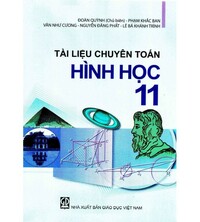Bài 1.52 trang 40 SBT đại số và giải tích 11
Giải bài 1.52 trang 40 sách bài tập đại số và giải tích 11. Giải các phương trình sau...
Đề bài
Giải phương trình sau
\(\cot x - 1 = \)
\(\dfrac{{\cos 2x}}{{1 + \tan x}} + {\sin ^2}x - \dfrac{1}{2}\sin 2x\).
Phương pháp giải - Xem chi tiết
Tìm ĐKXĐ của phương trình.
ĐKXĐ của hàm số dạng \(y = \dfrac{{f(x)}}{{g(x)}}\) là \(g(x) \ne 0\).
Sử dụng công thức \(\cot x = \dfrac{1}{{\tan x}}\); công thức nhân đôi \(\cos 2x = 2{\cos ^2}x - 1\); \(\sin 2x = 2\sin x\cos x\); \(\dfrac{1}{{{{\sin }^2}x}} = 1 + {\cot ^2}x\); \(\dfrac{1}{{{{\cos }^2}x}} = {\tan ^2}x + 1\) để đưa phương trình về phương trình của hàm \(\tan x\).
Sau đó ta đặt \(t = \tan x\) để phương trình dễ nhìn hơn.
Sử dụng hằng đẳng thức số ba \({a^2} - {b^2} = (a - b)(a + b)\) để thu gọn phương trình.
Lời giải chi tiết
ĐKXĐ: \(\sin x \ne 0\); \(\cos x \ne 0\) và \(\tan x \ne - 1\).
Ta có: \(\cot x = \dfrac{1}{{\tan x}}\);
\(\begin{array}{l}\cos 2x = 2{\cos ^2}x - 1\\ = 2\dfrac{1}{{{{\tan }^2}x + 1}} - 1\\ = \dfrac{{1 - {{\tan }^2}x}}{{{{\tan }^2}x + 1}}\end{array}\);
\(\begin{array}{l}{\sin ^2}x = 1 - {\cos ^2}x\\ = 1 - \dfrac{1}{{{{\tan }^2}x + 1}} = \dfrac{{{{\tan }^2}x}}{{{{\tan }^2}x + 1}}\end{array}\);
\(\begin{array}{l} - \dfrac{1}{2}\sin 2x = - \sin x\cos x\\ = - \dfrac{{\sin x}}{{\cos x}}{\cos ^2}x = - \tan x\dfrac{1}{{{{\tan }^2}x + 1}}\end{array}\)
Phương trình \(\cot x - 1 \)
\(=\dfrac{{\cos 2x}}{{1 + \tan x}} + {\sin ^2}x - \dfrac{1}{2}\sin 2x\)
\( \Leftrightarrow \dfrac{1}{{\tan x}} - 1 \)
\(=\dfrac{{\dfrac{{1 - {{\tan }^2}x}}{{{{\tan }^2}x + 1}}}}{{1 + \tan x}} + \dfrac{{{{\tan }^2}x}}{{{{\tan }^2}x + 1}} - \dfrac{{\mathop{\rm \tan x}\nolimits} }{{{{\tan }^2}x + 1}}\)
Đặt \(t = \tan x\) ta được \(\dfrac{1}{t} - 1 = \dfrac{{\dfrac{{1 - {{\mathop{\rm t}\nolimits} ^2}}}{{{{\mathop{\rm t}\nolimits} ^2} + 1}}}}{{1 + {\mathop{\rm t}\nolimits} }} + \dfrac{{{{\mathop{\rm t}\nolimits} ^2}}}{{{{\mathop{\rm t}\nolimits} ^2} + 1}} - \dfrac{{\mathop{\rm t}\nolimits} }{{{{\mathop{\rm t}\nolimits} ^2} + 1}}\)
\( \Leftrightarrow \dfrac{1}{t} - 1 = \dfrac{{1 - t}}{{{t^2} + 1}} + \dfrac{{{t^2} - t}}{{{t^2} + 1}}\)
\( \Leftrightarrow \dfrac{{1 - t}}{t} = \dfrac{{1 - t}}{{{t^2} + 1}} + \dfrac{{t(t - 1)}}{{{t^2} + 1}}\)
\( \Leftrightarrow \left[ \begin{array}{l}1 - t = 0\\\dfrac{1}{t} = \dfrac{1}{{{t^2} + 1}} - \dfrac{t}{{{t^2} + 1}}\end{array} \right.\)
\( \Leftrightarrow \left[ \begin{array}{l}t = 1\\{t^2} + 1 = (1 - t)t\end{array} \right.\)
\( \Leftrightarrow \left[ \begin{array}{l}t = 1\\2{t^2} - t + 1 = 0\text{(vô nghiệm)}\end{array} \right.\)
\(\begin{array}{l}t = 1 \Leftrightarrow \tan x = 1\\ \Leftrightarrow x = \dfrac{\pi }{4} + k\pi \in \mathbb{Z}\text{(thỏa mãn)}\end{array}\)
Vậy phương trình có nghiệm là \(x = \dfrac{\pi }{4} + k\pi \in \mathbb{Z}\).
Search google: "từ khóa + timdapan.com" Ví dụ: "Bài 1.52 trang 40 SBT đại số và giải tích 11 timdapan.com"







